
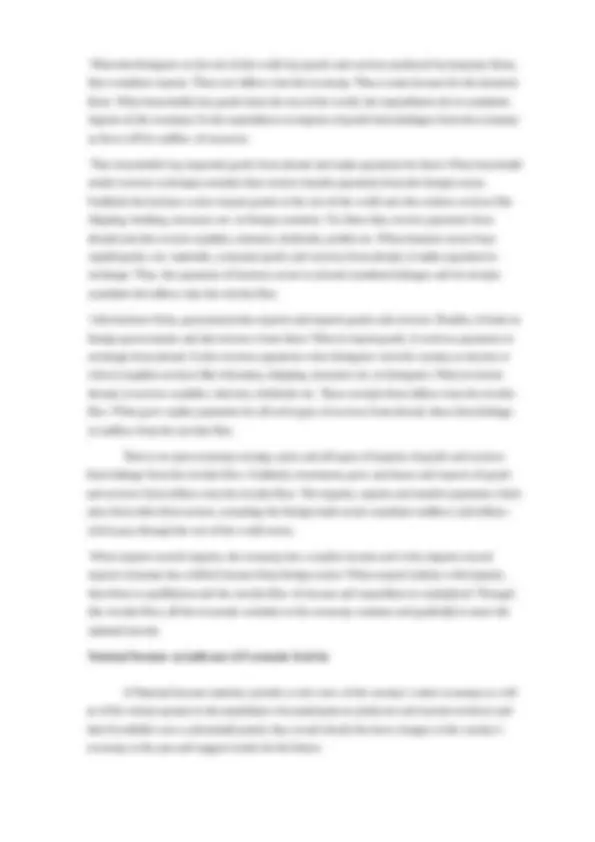
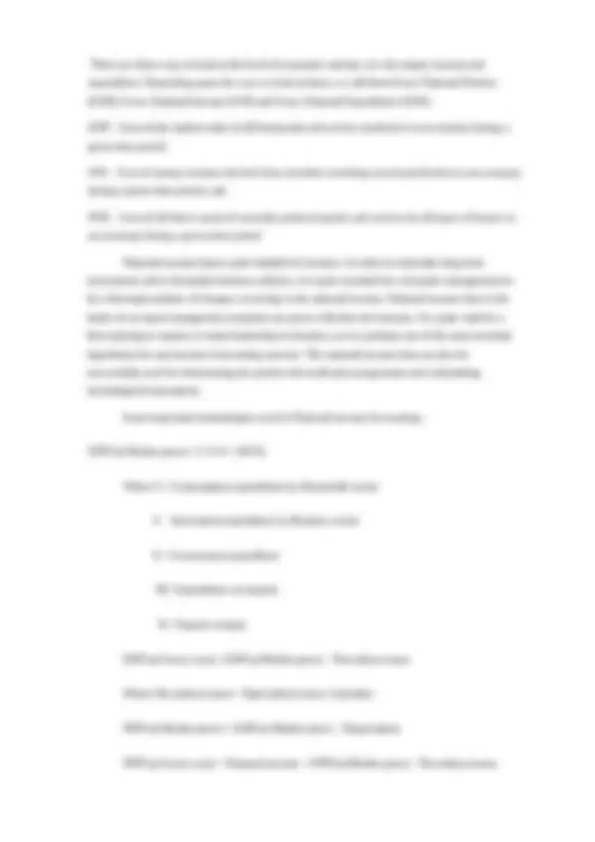
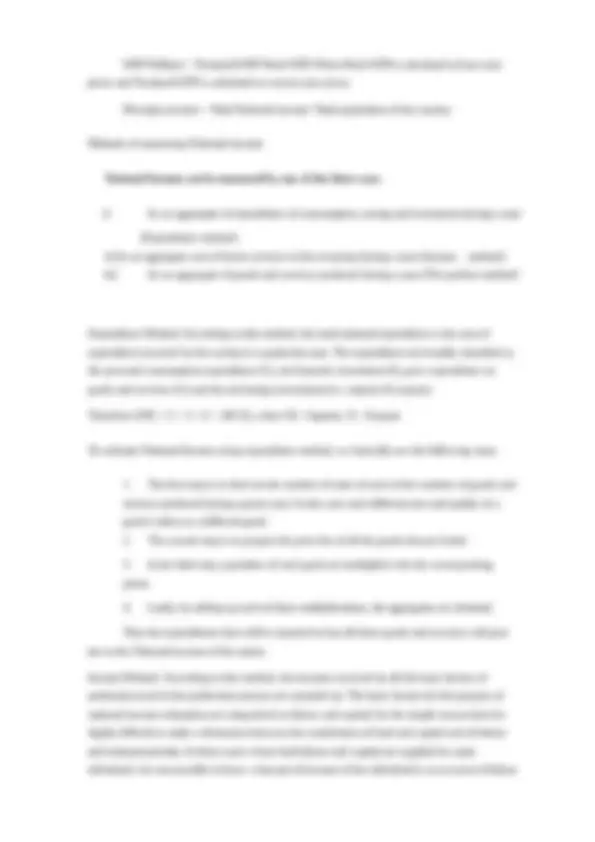
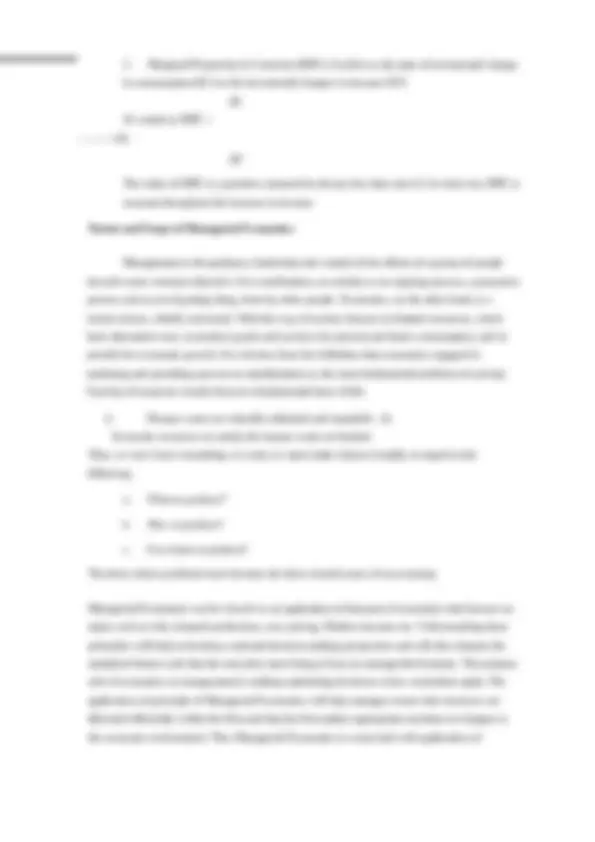
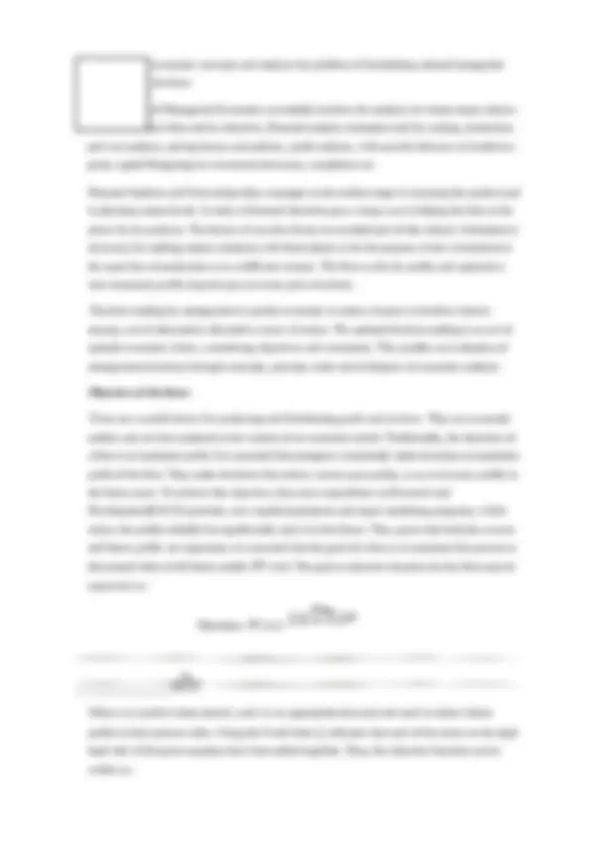
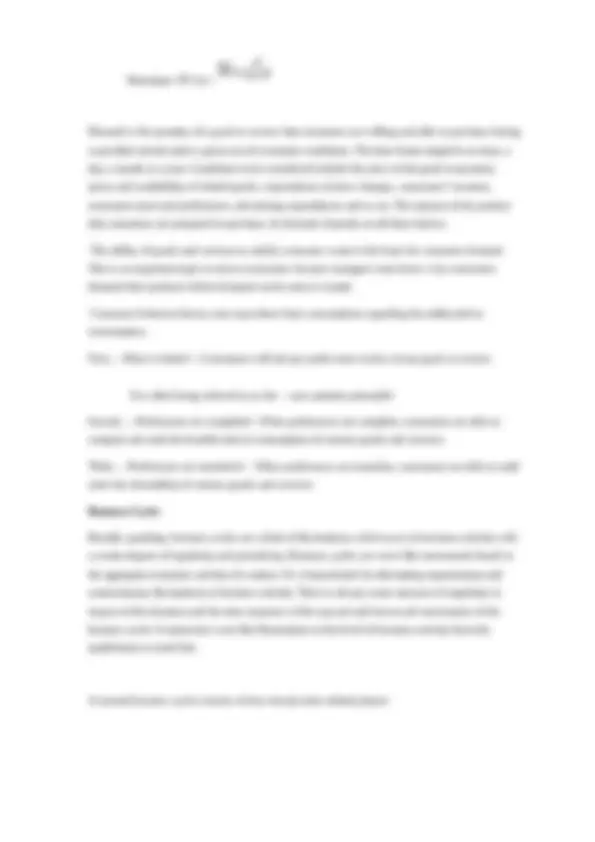


Study with the several resources on Docsity

Earn points by helping other students or get them with a premium plan


Prepare for your exams
Study with the several resources on Docsity

Earn points to download
Earn points by helping other students or get them with a premium plan
Community
Ask the community for help and clear up your study doubts
Discover the best universities in your country according to Docsity users
Free resources
Download our free guides on studying techniques, anxiety management strategies, and thesis advice from Docsity tutors
details of the concepts is stated in the course pack for easy reading
Typology: Study Guides, Projects, Research
1 / 12

This page cannot be seen from the preview
Don't miss anything!







A Jesuit Business School St. Joseph’s College (Autonomous), Tiruchirappalli 620 002 18PBA1106- MANAGERIAL ECONOMICS
Faculty: Dr.Annette, Dr. Thandeeswaran&Mr.Joan kingsly Sessions: 40 Credits: 4 Macro Economic policies – An overview
Economics is the science of making decisions in the presence of scarce resources. Resources are simply anything used to produce a good or service to achieve a goal. Economic decisions involve the allocation of scarce resources so as to best meet the managerial goal. The nature of managerial decision varies depending on the goals of the manager. A Manager is a person who directs resources to achieve a stated goal and he/she has the responsibility for his/her own actions as well as for the actions of individuals, machines and other inputs under the manager’s control. Managerial economics is the study of how scarce resources are directed most efficiently to achieve managerial goals. It is a valuable tool for analyzing business situations to take better decisions. Prof. Evan J Douglas defines Managerial Economics as “Managerial Economics is concerned with the application of economic principles and methodologies to the decision making process within the firm or organization under the conditions of uncertainty” According to Milton H Spencer and Louis Siegelman “Managerial Economics is the integration of economic theory with business practices for the purpose of facilitating decision making and forward planning by management” According to Mc Nair and Miriam , ‘Managerial Economics consists of the use of economic modes of thoughts to analyze business situations’. Economics can be divided into two broad categories: micro economics and macroeconomics. Macroeconomics is the study of the 6 economic system as a whole. It is related to issues such as determination of national income, savings, investment, employment at aggregate levels, tax collection, government expenditure, foreign trade, money supply etc., Micro economics focuses on the behavior of the individuals, firms and their interaction in markets. Managerial economics is an application of the principles of micro and macro economics in managerial decision making. The economic way of thinking about business decision making provides all managers with a powerful set of tools and insights for furthering the goals of their organization. Successful managers take good decisions, and one of their most useful tools is the methodology of managerial economics.
The term Macro Economics applies to the study of relation between broad economic aggregates. It‘s the theory of income, employment, prices and money. It‘s the study of economic system as a whole. It‘s that branch of economic analysis which studies the behaviour of not one particular unit, but of all the units taken together, like total national income, out put and employment, total consumption, saving and investment, aggregate demand and supply and general
level of prices. It thus becomes the study of aggregates and is often called ―Aggregative Economics‖ as it studies the behaviour of these aggregates over time and space. Macro economics is of great help in the fluctuation of economic policies. The days of ―Laissez-faire‖ are over and govt. intervention in economic matters is an accomplished fact. Government deals not with individuals but with groups and masses of individuals, thereby establishing the importance of macro economic studies. The theory of economic fluctuations can be understood and built up only with the help of macro economics. We are led to analyse the cause of fluctuations in income, output and employment, and make attempts to control them or at least to reduce their severity. A circular flow of income:
It‘s the process in which the national income and national expenditure of an economy flow in a circular manner. This process takes place continuously through the activities like production and sale of final product and generation of income.
The actual economy is an open economy which includes four steps consisting of house hold sector, business sector, govt. sector and the rest of the world sector or foreign trade sector.
There are three ways to look at the level of economic activity, viz. the output, income and expenditure. Depending upon the way we look at them, we call them Gross National Product (GNP), Gross National Income (GNI) and Gross National Expenditure (GNE) GNP – Sum of the market value of all final goods and service produced in an economy during a given time period. GNI – Sum of money incomes derived from activities involving current production in an economy during a given time period; and GNE – Sum of all that is spent of currently produced goods and services by all types of buyers in an economy during a given time period. National income data is quite helpful for business. In order to undertake long term investments and to formulate business policies, it is quite essential for a dynamic management to do a thorough analysis of changes occurring in the national income. National income data in the hands of an expert managerial economist can prove a life-line for business. It‘s quite vital for a firm aspiring to capture or retain leadership in business, as it is perhaps one of the most essential ingredients for any business forecasting exercise. The national income data can also be successfully used for determining the product diversification programme and undertaking technological innovations.
Some important terminologies used in National income Accounting:-
GDP (at Market price):- C+I+G+ (M-X)
Where C= Consumption expenditure by Household sector
I= Investment expenditure by Business sector
G= Government expenditure
M= Expenditure on imports
X= Exports receipts
GDP (at Factor cost):- GDP (at Market price) – Net indirect taxes
Where Net indirect taxes= Total indirect taxes- Subsidies
NNP (at Market price) = GDP (at Market price) – Depreciation
NNP (at Factor cost) = National income = NNP (at Market price) – Net indirect taxes
GDP Deflator = Nominal GDP/ Real GDP, Where Real GDP is calculated at base year prices and Nominal GDP is calculated at current year prices.
Percapita income = Total National income/ Total population of the country
Methods of measuring National income:
National Income can be measured by any of the three ways
i) As an aggregate of expenditure of consumption, saving and investment during a year (Expenditure method) ii) As an aggregate cost of factor services in the economy during a year (Income method) iii) As an aggregate of goods and services produced during a year (Net product method)
Expenditure Method: According to this method, the total national expenditure is the sum of expenditure incurred by the society in a particular year. The expenditure are broadly classified as the personal consumption expenditure (C), net domestic investment (I), govt. expenditure on goods and services (G) and the net foreign investment (i.e. imports & exports) Therefore GNE = C + I + G + (M-X), where M = Imports, X = Exports
To estimate National Income using expenditure method, we basically use the following steps:
Income Method: According to this method, the incomes received by all the basic factors of production used in the production process are summed up. The basic factors for the purpose of national income estimation are categorized as labour and capital, for the simple reason that it is highly difficult to make a distinction between the contribution of land and capital and of labour and entrepreneurship. In those cases where both labour and capital are supplied by same individual, it is not possible to know what part of income of the individual is an account of labour
country. The flow of savings into the capital market, in turn, results in flow out of the capital market in the form of funds for consumer credit, for private investment spending and for government borrowings (to finance spending in excess for tax revenues). So, on the demand side, we have four basic things: i) Personal consumption expenditure (C) ii) Private Investment spending (I) iii) Govt. expenditure on goods and service (G) iv) Export of goods and services abroad (X) Thus the aggregate demand or aggregate expenditure = C + I + G + X
The economy is in equilibrium when aggregate demand equals aggregate supply. That is
C + S + T + M = C + I + G + X
S + T + M = I + G + X
Consumption Function:
Consumption refers to the part of income spent by households on the purchase of final consumer goods and services in the economy. An important tool of economic analysis is the consumption function which establishes the relationship between income and consumption in an economy consumption function (C.F) is expressed by C = F (y) –––––– (1) It show that consumption increases as income increases, but less than proportionately. It‘s because of the existence of ―psychological law of consumption‖ which states that, ―Men are disposed as a rule and on the average to increase their consumption as their income increases, but not by as much as the increase in income. To explain the relationship between income and consumption we can divide the consumption function (C.F) into two types.
Y
The value of APC can be equal to, greater than or less than one. In short run, APC declines as income increases.
ΔY The value of MPC is a positive constant but always less than one (1). In short run, MPC is constant throughout the increase in income. Nature and Scope of Managerial Economics
Management is the guidance, leadership and control of the efforts of a group of people towards some common objective. It is coordination, an activity or an ongoing process, a purposive process and an art of getting thing, done by other people. Economics, on the other hand, is a social science, chiefly concerned. With the way of society chooses its limited resources, which have alternative uses, to produce goods and services for present and future consumption, and to provide for economic growth. It is obvious from his definition that economics engaged in analyzing and providing answers to manifestation us the most fundamental problem of scarcity. Scarcity of resources results from two fundamental facts of life. i) Human wants are virtually unlimited and insatiable. ii) Economic resources to satisfy the human wants are limited. Thus, we can‘t have everything we want; we must make choices broadly in regard to the following. a. What to produce? b. How to produce? c. For whom to produce? The three choice problems have become the three central issues of an economy.
Managerial Economics can be viewed as an application of that part of economics that focuses on topics such as risk, demand production, cost, pricing, Market structure etc. Understanding these principles will help to develop a rational decision making perspective and will also sharpen the analytical frame work that the executive must bring to bear on managerial decisions. The primary role of economics in management is making optimizing decisions where constraints apply. The application of principle of Managerial Economics will help manager ensure that resources are allocated efficiently within the firm and that the firm makes appropriate reactions to changes in the economic environment. Thus Managerial Economics is concerned with application of
Maximize: PV (π) =
Demand is the quantity of a good or service that customers are willing and able to purchase during a specified period under a given set of economic conditions. The time frame might be an hour, a day, a month or a year. Conditions to be considered include the price of the good in question, prices and availability of related goods, expectations of price changes, consumers‘ incomes, consumers taste and preferences, advertising expenditures and so on. The amount of the product that consumers are prepared to purchase, its demand, depends on all these factors.
The ability of goods and services to satisfy consumer wants is the basis for consumer demand. This is an important topic in micro-economics because managers must know why consumers demand their products before demand can be met or created.
Consumer behavior theory rests upon three basic assumptions regarding the utility tied to consumption.
First, ―More is better‖ :- Consumers will always prefer more to less of any good or service.
It is often being referred to as the ―non satiation principle‖.
Second, ―Preferences are complete‖:- When preferences are complete, consumers are able to compare and rank the benefits tied to consumption of various goods and services.
Third, ―Preferences are transitive‖ :- When preferences are transitive, consumers are able to rank/ order the desirability of various goods and services.
Business Cycle:
Broadly speaking, business cycles are a kind of fluctuations which occur in business activity with a certain degree of regularity and periodicity. Business cycles are wave like movements found in the aggregate economic activity of a nation. It‘s characterized by alternating expansionary and contractionary fluctuations in business activity. There is always some measure of regularity in respect of the duration and the time sequence of the upward and downward movements of the business cycle. It represents wave like fluctuations in the level of business activity from the equilibrium or trend line.
A normal business cycle consists of four closely inter-related phases:
i. Revival / Recovery The “Peak” or “Ceiling” on the one hand and the “Trough” or “Floor”, on ii. Expansion / Prosperity the other hand, represents critical iii. Recession / Down turn turning points in the Trade/Business Cycle iv) Contraction / Depression
iii.i. Recovery – This is a period when the industrialists and the businessmen repay the loans taken by them from banks earlier and the frozen stocks held by the banks are released. Stocks of good remain below the normal with the shopkeepers. Once the recovery starts, it results in a snowballing process for investment. The result is that demand orders pour in and the produces get stimulus and encouragement to produce more. iii.i. Prosperity – It‘s a state of affairs in which the real income consumed, the real income produced and the level of employment are high or rising and there are no idle resources or unemployed workers or very few either. In other words during prosperity, economic affairs and activities are at the optimum level and there is no wastage of resources of any kind. The level of wages and prices is also high, though wages lag behind prices. But with the passage of time, resources which are fully employed become scarce, output becomes less elastic, bottlenecks appear, costs rise, deliveries become difficult – all these combine to give a boost to the rising volume of money. The rise in price level is also not uniform leading to distortions in the price structure. These lags and distortions bring about an end of cumulative expansion or prosperity phase of the cycle and the recession begins giving way to contraction, depression or regular slump. iii.ii. Recession: It‘s an imprecise term given to sharp slowdown in the rate of economic growth or a modest decline in economic activity. Recession though spread over a short span of time, marks the turning point during which the forces that make for regular slump or depression finally win over and come to prevail. Once a recession starts, it tends to feed upon itself, like wild fire in a forest.
. The recession generates such complex forces as lead the entire system to a head long crash. Its outward signs are the decline in prices, liquidation of stock market, strain in banking system, increase in unemployment, liquidation of bank loans, decline in orders, construction activities. The collapse of confidence and weakening of expectations pave the way for recession